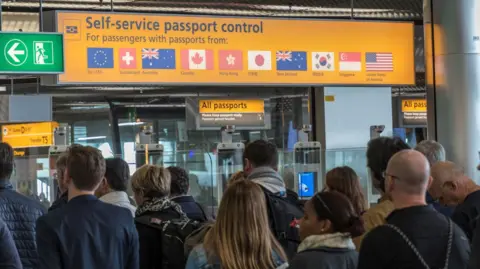
 Getty Images
Getty Images
The EU is planning to introduce a €7 (£6) EU visa waiver for some non-EU citizens, including Britons, by summer 2025.
Under new rules, visitors from a list of non-EU countries, including the UK, will need to apply for a waiver, similar to a US Esta, before travelling to 30 countries in Europe.
The waiver will cover travel to the Schengen area, which includes every EU state except for Ireland and Cyprus, as well as Iceland, Liechtenstein, Norway and Switzerland.
Here's what you need to know about how the new scheme will operate and when it will start.
How does the EU visa waiver scheme work?
The new scheme will be called the European Travel Information and Authorisation System (Etias).
Currently, visitors from the UK can visit the EU's borderless Schengen area for up to 90 days every 180 days without a visa.
This is also the case for citizens of more than 60 non-EU countries, including the US, Japan and Australia.
Under the Etias scheme, this will change.
Visitors from the non-EU countries on the list will need to apply for a visa waiver to travel to the EU for the same duration of 90 days every 180 days. Longer stays will require a visa.
The document will be checked by border guards when crossing the EU border.
The full list of non-EU countries eligible for Etias is published by the EU.
The visa waiver will last for three years and allow an unlimited number of visits.
It will be linked to your passport, so if your passport expires in less than three years, you will need to apply for a new Etias when you get a new one.
How much will the Etias cost?
The waiver will cost €7 for most people, which the EU Commission says is "way cheaper" than the US Esta, which costs $21 (€18.80; £16) as of 19 July this year.
The fee will apply to anyone between the ages of 18 and 70.
The waiver will be free for children and the over-70s.
When will the Etias scheme start?
The EU has not announced a firm start date for the waiver scheme yet.
Its website says it will start in "the first half of 2025".
The EU says the Etias requirement will not be enforced for a period of "at least six months" at first, although it recommends all visitors apply for a visa waiver.
A Home Office spokesperson said the UK expects the EU to provide more information on the rollout of the scheme "in due course".
How will waiver applications work?
Passengers will need to apply online or via a mobile app. The form - which the EU describes as a "necessary and small procedural step" - will take around 10 minutes to complete, authorities say.
The details needed for the application form will include passport information as well as background questions about criminal records and medical conditions.
More than 95% of applications will be approved automatically within minutes, the EU says. However, it warns that in some cases may take up to 72 hours.
Applications may also be denied or take up to four weeks to process in exceptional circumstances.
Why is the scheme being introduced?
The EU has decided to bring in more border controls as a response to the migrant crisis and concerns over terrorism.
It says the Etias system will "strengthen security checks on those persons who travel visa-free to the EU".
According to the EU website, the Etias will help EU states "assess potential risks" posed by people entering their borders.
It is aimed at preventing "cross-border crime and terrorism," the website says.
What is the EES?
Another EU border scheme, called the Entry/Exit System (ESS), is launching on 10 November after a series of delays.
Commissioner Johansson says the EES system will mean strict digital border controls at "every single airport," "harbour" and "road into Europe".
The rules will mean "we will know if people stay too long" and "will make it harder for criminals, terrorists or Russian spies to use fake passports," she says.
Under the EES scheme, people entering the EU will have to register fingerprints, a photo and passport details.
That initial registration will be valid for three years, during which time it will need to be validated every time someone crosses the border. This will replace passport stamping.
However, long queues have been predicted, with experts warning the EES could add at least two minutes processing time per passenger, compared with the current 45 seconds.

 4 months ago
19
4 months ago
19









